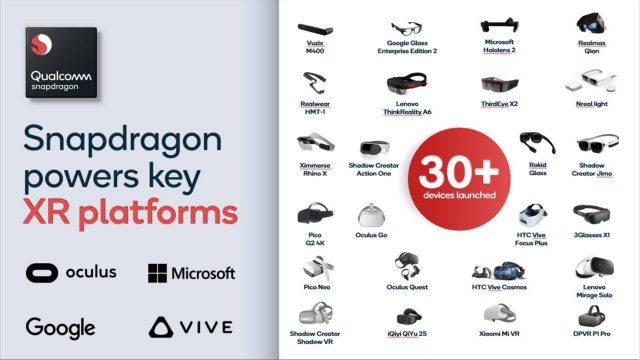
Qualcomm has been using its heft as a mobile chip maker to accelerate the development of AR and VR devices because it believes the ‘immersive compute’ category is the long term future of the smartphone. It’s still early days, but with more than 30 headsets with Qualcomm chips now on the market, the company has become the key enabler of mobile XR devices. With the recent launch of Snapdragon XR2, its latest and greatest made-for-XR chipset, the company has further expanded its commitment to the sector.
Speaking with Road to VR at CES 2020 this week, Qualcomm’s Head of XR, Hugo Swart, said that the company’s mobile Snapdragon chipsets are now in more than 30 AR and VR headsets, including leading standalone headsets like Oculus Quest, Go, Vive Focus, and HoloLens 2.

Chip makers like Intel, NVIDIA, and AMD have largely left the door open for Qualcomm to dominate the mobile portion of the XR space.
Intel was actually quite ahead of its time when it showed off one of the first standalone VR headset reference designs, codenamed Alloy, back in mid-2016. The company intended to work with partners to bring products based on Alloy to market, but Intel cancelled the project in 2017 due to what it said was a lack of partner interest. Intel also supplied the processor in the first HoloLens, but Microsoft made a decisive jump to Qualcomm’s Snapdragon for HoloLens 2.
Nvidia’s graphical prowess seems especially well suited for the needs of XR, which is deeply dependent on high performance real-time graphics. Indeed, on the PC side of the market, Nvidia GPUs absolutely dominate the VR landscape. In early 2018, Oculus reported that a staggering 92% of its Rift users were using Nvidia GPUs, an even greater dominance over AMD than in the general PC gaming space. But in the mobile XR space, Nvidia only has its chips in one major headset: Magic Leap.
Like Intel, AMD was eager about standalone VR early on. After acquiring a startup which was working on the concept, AMD revealed the Sulon Q, a standalone VR headset, powered by AMD, and also designed for pass-through AR. While Sulon Q was said to launch in late 2016, it was quietly cancelled and forgotten.
Qualcomm, on the other hand, has stuck it out. The company has sought to help interested partners rapidly bring XR devices to market by supplying Virtual Reality Development Kits (VRDK) and pairing companies with partner solutions and capable manufacturers.
Following the release of its first dedicated AR and VR chipset in 2018, Snapdragon XR1, Qualcomm doubled down with Snapdragon XR2, its first chip dedicated to the needs of high-end XR devices, and the first such chip to offer 5G. At CES 2020 this week, Qualcomm clarified that, while it had introduced the XR2 as the ‘XR2 5G’, the 5G radio is an optional component of the chipset.
The company also hinted that it will reveal a new VRDK reference design based on XR2 in the near future, likely at Mobile World Congress next month. Unlike the smartphone landscape, which tends to adopt new computing platforms year after year, Qualcomm’s Head of XR, Hugo Swart, said he expects XR2 to be a viable option for XR devices for several years.
Qualcomm also says that it expects the first real devices based on XR2 to hit the market in the second half of 2020.
This may or may not be related the collaboration that Qualcomm announced last month with Niantic, the creator of Pokemon Go; together the companies have committed to a “multi-year joint collaboration on an integrated design spanning AR glasses reference hardware, software, and cloud-components.”
The post Qualcomm Chips Now in More Than 30 Headsets, First XR2 Devices Expected in 2H 2020 appeared first on Road to VR.
from Road to VR https://ift.tt/2QwQYfu
via IFTTT
No comments:
Post a Comment